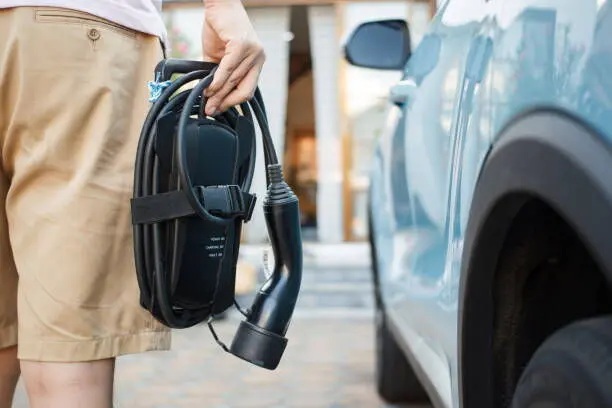The Ultimate Guide to Portable EV Chargers: Powering Your Drive, Anywhere
Introduction
Electric vehicles (EVs) are revolutionizing the way we travel. But for many new owners, a pressing question often arises: How do I charge my EV when I’m far from home or public charging stations? The answer lies in a growing innovation—portable EV chargers.
Compact, versatile, and increasingly essential, portable EV chargers allow drivers to power up their vehicles wherever a compatible outlet is available—at home, on a road trip, at work, or even at a remote cabin. As EV adoption accelerates, these chargers are becoming indispensable tools for convenient, worry-free driving.
In this comprehensive guide, we’ll explore how portable EV chargers work, their benefits, what to look for when purchasing one, and why they’re poised to be a key part of the EV future.
What Is a Portable EV Charger?
A portable EV charger is a lightweight, travel-friendly device that allows you to charge your vehicle’s battery using a standard power outlet—without needing a dedicated wall charger or public charging station.
Key Components:
- Control Box: The charger’s brain—it regulates voltage and current safely.
- Power Cable: Connects to a 120V or 240V outlet.
- Connector Plug: Attaches to your EV’s charge port (typically SAE J1772 in North America; Tesla vehicles include an adapter).
Most units fit easily in your car trunk or garage and are designed for quick setup and simple operation.
How Do Portable EV Chargers Work?
Portable EV chargers draw power from an outlet, convert it to the proper voltage, and transfer it safely to your EV. Here’s a simplified step-by-step breakdown:
- Plug In: Connect the charger to a standard 120V (Level 1) or 240V (Level 2) outlet.
- Regulate Power: The control box adjusts voltage and amperage for safe transfer.
- Connect to Vehicle: Insert the plug into your EV’s charging port.
- Monitor Charging: LED indicators, displays, or apps show status and battery levels.
Benefits of Portable EV Chargers
1. Charging Freedom
Charge wherever a compatible outlet is available—ideal for road trips, rural stays, or rentals without fixed chargers.
2. Independence from Public Infrastructure
With public stations still limited in some areas, a portable charger provides peace of mind in unfamiliar locations.
3. Budget-Friendly
Lower upfront cost compared to installing a fixed Level 2 unit. Plus, they can be shared across multiple vehicles or owners.
4. Plug-and-Play Simplicity
No need for professional installation—just plug it in and charge.
5. Compact and Convenient
Lightweight and often bundled with a storage case, they’re easy to carry and store.
6. Emergency Backup
If your battery runs low unexpectedly, a portable charger can get you back on the road from any standard outlet.
Charging Levels Explained
Understanding the types of charging helps you select the right portable charger for your needs:
Level 1 – 120V
- Source: Standard household outlet
- Speed: 3–5 miles of range/hour
- Best For: Overnight charging or emergencies
- Use Case: Typically included with EVs
Level 2 – 240V
- Source: Dryer/RV outlets or special installations
- Speed: 12–30 miles of range/hour
- Best For: Daily use, faster charging
- Use Case: Ideal for most portable chargers
Level 3 – DC Fast Charging
- Source: High-voltage direct current supply
- Speed: 80% charge in 20–60 minutes
- Best For: Highway rest stops, long-distance travel
- Use Case: Not supported by portable chargers due to power requirements
Tips for Effective Use
To get the most from your portable EV charger:
- Know Your Power Options: Determine which outlets (120V or 240V) are available where you’re going.
- Match Amperage to Vehicle: Ensure your EV supports the charger's maximum current.
- Adjust Amp Settings Carefully: Use the lowest safe setting if unsure about circuit limits.
- Use Proper Extension Cords: Only use heavy-duty, outdoor-rated cords.
- Monitor Progress: Use built-in indicators or apps to stay informed.
- Store Safely: Keep the unit dry, clean, and protected when not in use.
What to Look For Before Buying
When selecting a portable EV charger, consider:
1. Amperage & Output
- Ranges from 16A to 40A
- Higher amperage = faster charging (if your EV and circuit support it)
2. Cable Length
- 16 to 25 feet is typical; longer gives flexibility in tight spaces
3. Plug Compatibility
- Check whether the charger includes multiple outlet adapters (e.g., NEMA 14-50, 5-15, etc.)
4. Portability
- Look for lightweight designs with storage/carrying cases
5. Weather Resistance
- Outdoor-rated units offer protection against rain, dust, and snow
6. Safety Features
- Look for overcurrent, overvoltage, overheating, and short-circuit protection
- Ensure the charger meets UL, CE, or other relevant safety certifications
The Role of Portable Chargers in the EV Ecosystem
Portable chargers won’t replace fixed charging stations—but they’re ideal for:
- Apartment/Condo Dwellers: Charge without needing permanent infrastructure
- Fleets & Businesses: Charge multiple vehicles flexibly
- Emergency Use: Power up during outages or disasters (especially with generator support)
- Road Warriors: Charge at cabins, RV parks, or off-grid stops
The Future of Portable EV Charging
With advancements in battery and charging technology, future portable chargers will likely offer:
- Faster Level 2 charging speeds
- Smarter software with app control, scheduling, and data logging
- Lighter designs with universal plug compatibility
As public infrastructure catches up, portable chargers will continue to offer unmatched versatility, especially in underserved or rural areas.
Conclusion
A portable EV charger isn’t just a nice-to-have—it’s a smart investment in convenience, freedom, and preparedness. Whether you’re navigating a daily commute, heading out on an adventure, or preparing for the unexpected, portable charging puts power back in your hands—literally.
With the right unit in your trunk, you’ll never have to worry about your next charge, no matter where the road takes you. Learn more about Google SEO.





Comments